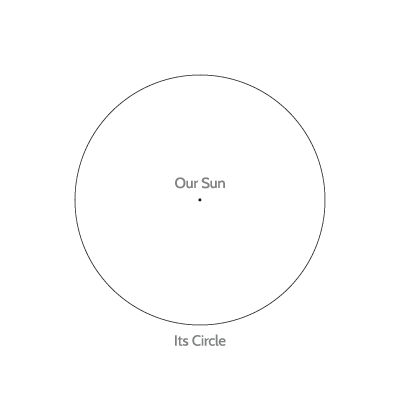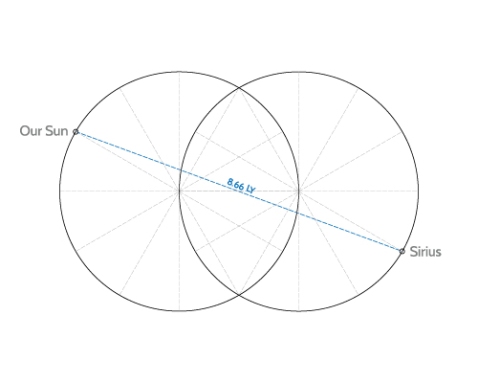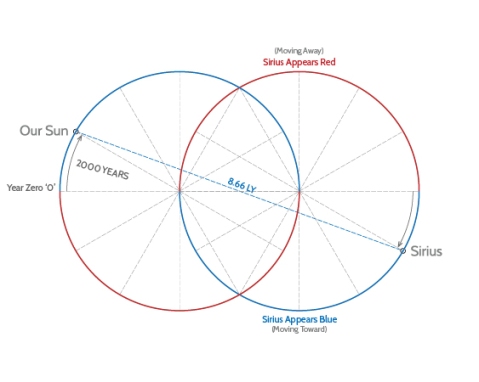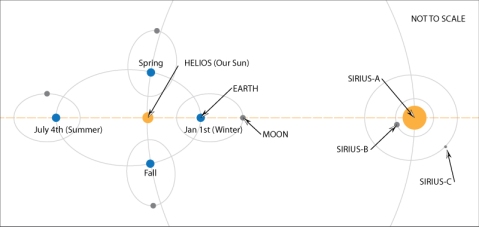How Our Sun Orbits Sirius
This may be common knowledge by now but it is essential to completely understand what is actually going on. There are many sources on the Internet talking about this so I’ll keep it short. Our sun is in a binary orbit with the Sirius system and is the reason for the precession of the zodiac and not the slow revolution of Earth’s poles. There is a lot of evidence for this and I’d like to present what I’ve learned here. Beginning with our circle again and the center point, we have a representation of our Sun and it’s boundary of influence. This not an exact representation but it’s very close. The sun is nearly a perfect sphere so it is safe to assume that its orbit is also very circular and not too eccentric. Now we add a second circle of the same radius that is offset to the edge of this one creating the Vesica Pisces in between them. Currently the two stars are starting to close-in on each other as they come around the bend from the farthest distance. Currently the two are about 8.66 light-years apart and they have been heading toward each other for about 2000 years now.
Now we add a second circle of the same radius that is offset to the edge of this one creating the Vesica Pisces in between them. Currently the two stars are starting to close-in on each other as they come around the bend from the farthest distance. Currently the two are about 8.66 light-years apart and they have been heading toward each other for about 2000 years now. It was observed before that time that Sirius appeared red. This makes sense because as stars move away from each other they appear red to someone looking at it. And when they move toward each other they would appear blue. Stars that do not move relative to each other will look white. The best evidence of Sirius being red comes from the Greek astronomer Claudius Ptolemy who in 150 A.D. wrote that Sirius was red in color. He compared Sirius to five other stars which are currently red stars today, Betelgeuse, Pollux, Aldebaran, Antares, and Arcturus.
It was observed before that time that Sirius appeared red. This makes sense because as stars move away from each other they appear red to someone looking at it. And when they move toward each other they would appear blue. Stars that do not move relative to each other will look white. The best evidence of Sirius being red comes from the Greek astronomer Claudius Ptolemy who in 150 A.D. wrote that Sirius was red in color. He compared Sirius to five other stars which are currently red stars today, Betelgeuse, Pollux, Aldebaran, Antares, and Arcturus. Some may believe that the precession of the equinoxes is caused by the slow and steady wobble of the Earth’s poles caused by gravitational forces from the Moon, Sun and partially Jupiter. The odds of this occurring naturally because of gravity are astronomical to say the least. The alternative is that we are in a binary orbit with Sirius which takes 24,000 years to complete. The reason for using the 24,000 year figure and not the 26,000 year one, which is currently calculated based on the movement of the stars, is because as the two stars approach each other, the closer they get the faster the will travel. Four-thousand years from now the rate of precession will increase.
Some may believe that the precession of the equinoxes is caused by the slow and steady wobble of the Earth’s poles caused by gravitational forces from the Moon, Sun and partially Jupiter. The odds of this occurring naturally because of gravity are astronomical to say the least. The alternative is that we are in a binary orbit with Sirius which takes 24,000 years to complete. The reason for using the 24,000 year figure and not the 26,000 year one, which is currently calculated based on the movement of the stars, is because as the two stars approach each other, the closer they get the faster the will travel. Four-thousand years from now the rate of precession will increase.
The Greek astronomer Hipparchus created his star catalog in 129 BCE. While comparing his observations with those made by earlier Babylonian astronomers, he noticed that the stars had shifted or rather that the Earth itself had shifted. He calculated that the rate of precession was 1 degree per century which is very close to todays value of 1 degree for every 72 years. His estimate would make sense as Helios would have been traveling at its slowest velocity relative to Sirius at this point in history (Around the time it was changing from red to blue). Sirius does not precess with the other stars. Instead it moves in the exact opposite direction to balance perfectly with Earth’s precession cycle and looks as though it is standing still relative to the other stars.
As mentioned before, Sirius is responsible for Earth’s orbital eccentricity since it is known that Earth’s perihelion/aphelion is in alignment with Sirius. The same way the Moons perihelion is directly related to its position relative to the Sun and the Earth. When the Moon is full, being in direct opposition to the Sun is when it is closest to Earth. This has never changed since the beginning of time. So it is safe to relate Sirius and Earth’s orbital eccentricity. As the Sun orbits Sirius, the nodes of Earth’s perihelion/aphelion axis are always 90 degrees to Sirius and this would cause the zodiac to rotate in the opposite direction that the Sun moves through them during a normal yearly cycle. In astrology we say the Sun begins in Aries and moves through Taurus, Gemini, Cancer, Leo, etc. Precession means to move backwards so as the Sun orbits Sirius, the stars move the opposite way. Currently we have just moved out of Pisces and into Aquarius or 30 degrees of the circle closer to Sirius.
This 24,000 year cycle is also called the “Great Year”, “Great Cycle”, or “Cycle of the Yugas”. There are other names but these are some common ones. There is a special event associated with this cycle which was recorded in history and then lost to antiquity but it resonates within us and is something we cannot forget as human beings. That is for another post.
25 responses to “How Our Sun Orbits Sirius”
Trackbacks / Pingbacks
- - June 16, 2020
- - February 25, 2021
- - February 25, 2021

Thank you for sharing your research on this~* My north node is conjunct Sirius -which I Love!). We as collective human consciousness are just beginning to understand our connection with the great Light of Sirius, and its impact on our evolution and role in our collective destiny. Much Love and Light!
wow. That is so weird. They move so smoothly. I always thought the sun was in the middle of our solar system. Sweet info.
Hi Magnetic Nature. i just wanted to say that i posted a post. LOL. and also i LOVE your Blog is amazing with all the info! 😀 take care..
Very interesting development of the idea. I wonder what your source is for “it is known that Earth’s perihelion/aphelion is in alignment with Sirius.” ?
Given that this article was written about 5 years ago the source eludes me. However, Sirius reaches its highest point (~16.5 degrees above the horizon) in the sky during aphelion and is exactly due-south at midnight. During perihelion, Sirius is exactly due-south at mid-day in its lowest position ~16.5 degrees below the horizon. Geometrically speaking, it is safe to assume, this is the case. But space is strange.
That sounds like you may be correct, making that an excellent piece of evidence for the conjecture! Thank you! Much obliged.-Laurence
I have been searching for people involved in the Sirius as the center solution and have found:
Karl-Heinz Homman
Uwe Homman
Dr. William Brown of Colorado State University.
Patrick Marsolek
But Patrick says he hasn’t continued with it.
That is actually an impressive list. It seems like you’ve spent a good deal of time researching this. I’m not sure how I can help but feel free to contact me if you need anything.
My name is Laurence Crossen and I have been interested in this since before Cruttenden published his book. If you learn of anyone else, especially if they have published articles with scientific rather than mystical content, I would appreciate learning about it. If you would be willing to add your full name to the list that would be great.
Plus:
Paul Smyres
Remelic on Magnetic Nature Word Press.
Niqnaq on Word Press.
Moonkoon on Word Press.
While I thought his book favored a brown dwarf, as of 2009 Cruttenden favors Sirius.
My name is Peter R. Shushmaruk. You may add me to your list of contacts/researchers. Unfortunately I am not aware of anyone, personally, that has information regarding this topic but I can contact you if I find others. There is defiantly a solid relationship between Sirius, our Sun and the Earth. And when you consider the [constant] geometric relationship they have over the course of the year, it is also very profound. There is something special going on here.
Well, the idea is to test the conjecture and find out whether it is true or not.
That’s right. I was going to add that all there is to do is prove it.
I am reproducing a paragraph from the ‘Introduction’ written by Swami Yukteswar Giri in AD 1894 to the book The Holy Sceince.
Quote” we learn from Oriental Astronomy that moons revolve around their planets, and planets turning on their axes revolve with their moons round the sun; and the sun with its planets and their moons, takes some stars for its dual and revolves around it in about 24,000 years of our earth- a celestial phenomenon, which causes the backward movement of the equinoctial points around the Zodiac. ” Unquote.
Sri.Yukteswar Giri is the Guru of Sri Swami Paramahamsa Yogananda, who wrote Autobiography of a Yogi.
Thank you for the Article. I would love to read more.
Have you heard of the book, Lost Star of Myth and Time by Walter Cruttenden? He is a professional astronomer who has researched this conjecture in depth. There is a new kindle edition for just $2.99 just out.
YES! I have heard of this book but I have not read t yet. Thank you for reminding me.
The new edition has a short new chapter #10 at the end (not mentioned in the contents).
A most interesting topic. In one of the 25 volumes written by the Austrian mystic Jakob Lorber between 1840 and 1865, it is stated that our sun orbits Sirius once in 28,000 years. It is also said that Sirius is orbited by 200 million suns and that the Sirius galaxy together with millions of other galaxies are orbiting a much larger central sun to form a super galaxy. Sounds to me very much like galaxy clusters and super clusters of modern astronomy. This statement documented in the mid 1800 is quite remarkable in view that the first galaxy was only discovered by Hubble in 1925.
Thank you for your comment. It is an interesting topic. Published a long time ago but still getting read so that’s good. 😉
Sirius Conjuncts my North Node (NN) of the Moon in my 1st house.
For me, Sirius is Conjunct my NN in the sign of Cancer.
Sirius is known for scorching as it’s the brightest Star in the sky and is heavily illuminated at that point in my Natal Chart. Sirius is known as the spiritual Sun.
The essence of Sirius is nourishing my true inner-person who can get swallowed by my ego and be put down by who I try to be and not who I really need and want to be.
The NN is my soul urge. It’s what pushes me to drive in life.
Cancer themes are home, family, and childhood which is all very Moon related. I have the urge to nourish my inner-self and I’ve had to let go of the people and things that do not support the true person I am striving to be.
Thank you Sirius for helping me find myself in my journey though this life.
And thank you for this article, it’s very interesting and seems quite likely to be true.
the link doesn’t work